The Intel SSD 710 (200GB) Review
by Anand Lal Shimpi on September 30, 2011 8:53 PM EST- Posted in
- Storage
- SSDs
- Intel
- Intel SSD 710
AnandTech Storage Bench 2011
Last year we introduced our AnandTech Storage Bench, a suite of benchmarks that took traces of real OS/application usage and played them back in a repeatable manner. I assembled the traces myself out of frustration with the majority of what we have today in terms of SSD benchmarks.
Although the AnandTech Storage Bench tests did a good job of characterizing SSD performance, they weren't stressful enough. All of the tests performed less than 10GB of reads/writes and typically involved only 4GB of writes specifically. That's not even enough exceed the spare area on most SSDs. Most canned SSD benchmarks don't even come close to writing a single gigabyte of data, but that doesn't mean that simply writing 4GB is acceptable.
Originally I kept the benchmarks short enough that they wouldn't be a burden to run (~30 minutes) but long enough that they were representative of what a power user might do with their system.
Not too long ago I tweeted that I had created what I referred to as the Mother of All SSD Benchmarks (MOASB). Rather than only writing 4GB of data to the drive, this benchmark writes 106.32GB. It's the load you'd put on a drive after nearly two weeks of constant usage. And it takes a *long* time to run.
1) The MOASB, officially called AnandTech Storage Bench 2011 - Heavy Workload, mainly focuses on the times when your I/O activity is the highest. There is a lot of downloading and application installing that happens during the course of this test. My thinking was that it's during application installs, file copies, downloading and multitasking with all of this that you can really notice performance differences between drives.
2) I tried to cover as many bases as possible with the software I incorporated into this test. There's a lot of photo editing in Photoshop, HTML editing in Dreamweaver, web browsing, game playing/level loading (Starcraft II & WoW are both a part of the test) as well as general use stuff (application installing, virus scanning). I included a large amount of email downloading, document creation and editing as well. To top it all off I even use Visual Studio 2008 to build Chromium during the test.
The test has 2,168,893 read operations and 1,783,447 write operations. The IO breakdown is as follows:
| AnandTech Storage Bench 2011 - Heavy Workload IO Breakdown | ||||
| IO Size | % of Total | |||
| 4KB | 28% | |||
| 16KB | 10% | |||
| 32KB | 10% | |||
| 64KB | 4% | |||
Only 42% of all operations are sequential, the rest range from pseudo to fully random (with most falling in the pseudo-random category). Average queue depth is 4.625 IOs, with 59% of operations taking place in an IO queue of 1.
Many of you have asked for a better way to really characterize performance. Simply looking at IOPS doesn't really say much. As a result I'm going to be presenting Storage Bench 2011 data in a slightly different way. We'll have performance represented as Average MB/s, with higher numbers being better. At the same time I'll be reporting how long the SSD was busy while running this test. These disk busy graphs will show you exactly how much time was shaved off by using a faster drive vs. a slower one during the course of this test. Finally, I will also break out performance into reads, writes and combined. The reason I do this is to help balance out the fact that this test is unusually write intensive, which can often hide the benefits of a drive with good read performance.
There's also a new light workload for 2011. This is a far more reasonable, typical every day use case benchmark. Lots of web browsing, photo editing (but with a greater focus on photo consumption), video playback as well as some application installs and gaming. This test isn't nearly as write intensive as the MOASB but it's still multiple times more write intensive than what we were running last year.
As always I don't believe that these two benchmarks alone are enough to characterize the performance of a drive, but hopefully along with the rest of our tests they will help provide a better idea.
The testbed for Storage Bench 2011 has changed as well. We're now using a Sandy Bridge platform with full 6Gbps support for these tests. All of the older tests are still run on our X58 platform.
AnandTech Storage Bench 2011 - Heavy Workload
We'll start out by looking at average data rate throughout our new heavy workload test:
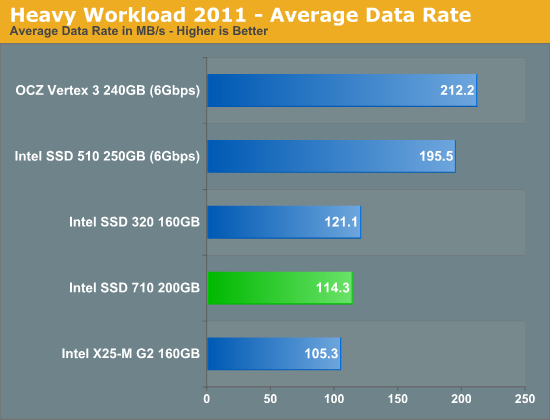
I threw in our standard desktop tests just to hammer home the point that the 710 simply shouldn't be used for client computing. Not only is MLC-HET overkill for client workloads, but the Intel SSD 320's firmware is better optimized for client computing.
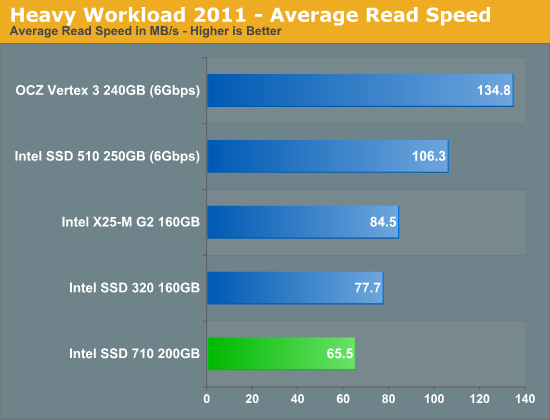
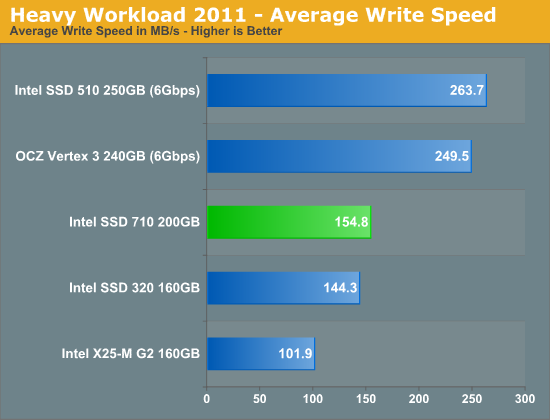
The next three charts just represent the same data, but in a different manner. Instead of looking at average data rate, we're looking at how long the disk was busy for during this entire test. Note that disk busy time excludes any and all idles, this is just how long the SSD was busy doing something:
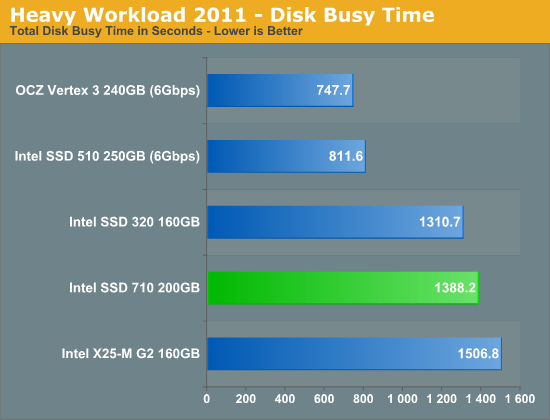
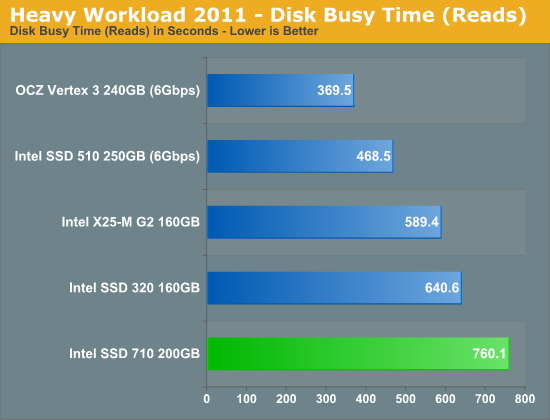
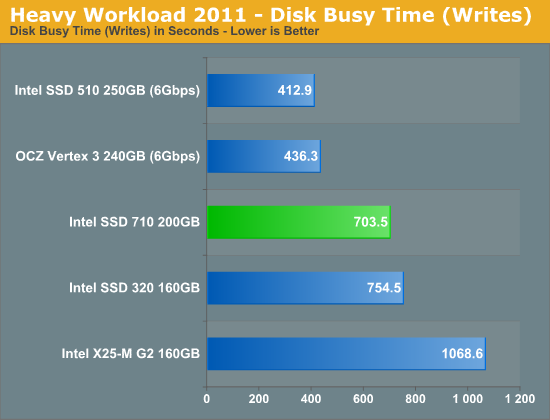










68 Comments
View All Comments
AnnonymousCoward - Sunday, October 2, 2011 - link
Use a CD; that's mechanical storage.Flash is definitely a poor choice, since charge is slowly lost. I'm not sure about magnetic hard drives.
ggathagan - Monday, October 3, 2011 - link
If you use optical media, better have it a manufactured ROM disk, as opposed to writable media.Even the best consumer optical media is only good for around 10 years.
James5mith - Monday, October 3, 2011 - link
One thing intel and the rest of the SSD crowd by far have failed to address is the limitations of SATA for enterprise workloads. Doesn't matter how fast your drive is, on a SATA interface it will tank in truly heavy mixed I/O environments. Native SAS SSD's are needed to move the hdd form factor SSD's forward in the industry.That being said, in my research for an in-house project, I discovered Smart Modular. Their Optimus SAS SSD's are up to 1.6TB/drive, and at that capacity are still below $3/GB.
To be fair, I have not gotten any of them in house to test yet, so I can't say how well they will do. But knowing the difference moving from SATA to SAS drives make in an array, I would have to imagine it will be significant when I do.
Not to mention, from a pure density standpoint, 1.6TB 2.5" SSDs can pack more density per rack unit than 3TB 3.5" drives. Once you get to the 4TB 3.5" drives, the crown returns to slow spinning media though.
jhh - Monday, October 3, 2011 - link
A conventional HDD wouldn't fare much better. The typical service life of an enterprise HDD is 5 years after a storage period of no more than 6 months. Beyond that point, the MTBF numbers aren't valid. That doesn't mean the drive will immediately fail. But, conventional HDDs aren't meant to be stored for a long period of time. The lubricating medium (grease or oil) will start moving away from where it is supposed to be, so that parts which were supposed to be lubricated won't be lubricated. The lubricant may also start oxidizing, becoming less of a lubricant. I'm not sure that a drive sitting around for 5 years will be any worse than a drive which was operating for 5 years, but I wouldn't count on either to be around for 20 years, let alone 50.If you want to be sure those baby pictures will still be around to show their grandkids, best to print the pictures, as we have never developed a better archival storage device. Better yet, paint it in some obscure cave in France. If you want the time capsule information to be available, print it on archival paper with archival inks.
rikmorgan - Tuesday, October 11, 2011 - link
I see an article in EE Times saying Samsung is producing flash NAND on their new 20nm FAB now and expects to begin running it at 10nm next year. Just passing it on, don't know how newsworthy it is. ET Times 10/10/2011 edition.Linkpl4y - Saturday, October 15, 2011 - link
Well you've made it this far. Hopefully you've learned something on the way.Here's the next path on your journey. http://bit.ly/nqPUwd
Iketh - Monday, October 17, 2011 - link
LOLmayaw - Saturday, November 5, 2011 - link
Because I do video graphics and its really the only thing that slows my system down for any type of reference # on tests. Even with a 10,000 RPM drive I have 12gb of mem and I upgrade my processor every 3-4 years when I can but I really never think of the hard drive. But now I am seriously thinking about getting one of these.Oh and by the way guys I think that the collar of his shirt is stretched out because his head is so big and it has to stretch itself out cause of the big brain he has in it unlike ppl who are arguing about someone that is wearing a t-shirt on a hard drive review.